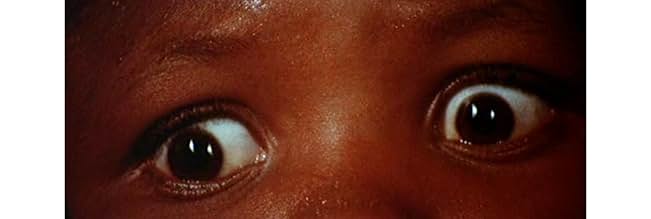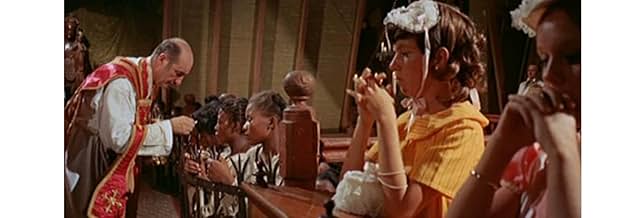VALUTAZIONE IMDb
6,5/10
1979
LA TUA VALUTAZIONE
Aggiungi una trama nella tua linguaTwo documentary filmmakers go back in time to the pre-Civil War American South to film the slave trade.Two documentary filmmakers go back in time to the pre-Civil War American South to film the slave trade.Two documentary filmmakers go back in time to the pre-Civil War American South to film the slave trade.
- Regia
- Sceneggiatura
- Star
Stefano Sibaldi
- Narrator
- (voce)
Dick Gregory
- Self
- (non citato nei titoli originali)
Gualtiero Jacopetti
- Self
- (non citato nei titoli originali)
Ernest Kubler
- Whip
- (non citato nei titoli originali)
Yayoi Kusama
- Self
- (non citato nei titoli originali)
Franco Prosperi
- Self
- (non citato nei titoli originali)
Shelley Spurlock
- Girl
- (non citato nei titoli originali)
Recensioni in evidenza
Not exactly a "humanitarian masterpiece" as someone else said (yeah right!). More like cryptic super-exploitation. This is wildly, hilariously, rollickingly misguided pseudo-history at best. Outright race-baiting at worst. Made by the sleazoids who barfed up "Africa Addios" (giving Africans their own country back so soon just wasn't the right idea, was it!!), a film that featured the genuinely bizarre white South African girls on trampolines montage. A fervent call-to-arms for African-Americans made by white Europeans must inherently ring false, I am afraid. (we enslaved you. kill us!) Manages to be both numbing and completely, hideously insulting at the same time.
The film is, under its very "SO racist it isn't being racist" exterior a sly work of racism. Presents blacks as nothing more than animals and savages, capable only of violence or submission to the will of whites. All the while remaining mute and mindless. No African-American in the film is presented as having a personality, substance, or intelligence. Every white all but glows. Every caucasian is a verbose, mercurial, immaculate sprite.
That said, the film does (I would assume) approximate the way Africans were treated during the slave era more closely than other films. In that respect it deserves respect. The conditions are shown as filthy, disgusting, cruel. Every imaginable indignity is portrayed (and some you probably could not imagine).
However, the film does have some power. The camera work is very inventive and the directors handle some of the chaotic scenes around the plantation very well. Some of the imagery is genuinely striking. There's a general feeling of chaos that comes through that's very effective. I'm not sure what the point is. But it's effective.
Anyway, see the movie if you really want to be grossed out and insulted. File this one under SUPER exploitation. The directors may have had good intentions when they started out, but I think they just lost it when they got onto the set and decided to see how far out they could go. And no one, it seemed, was around to tell them to tone it down or put on the breaks. This is up there with Cannibal Holocaust and Men Behind the Sun. It's that sort of a deal.
But don't kid yourselves, this AIN'T no humanitarian masterpiece.
The film is, under its very "SO racist it isn't being racist" exterior a sly work of racism. Presents blacks as nothing more than animals and savages, capable only of violence or submission to the will of whites. All the while remaining mute and mindless. No African-American in the film is presented as having a personality, substance, or intelligence. Every white all but glows. Every caucasian is a verbose, mercurial, immaculate sprite.
That said, the film does (I would assume) approximate the way Africans were treated during the slave era more closely than other films. In that respect it deserves respect. The conditions are shown as filthy, disgusting, cruel. Every imaginable indignity is portrayed (and some you probably could not imagine).
However, the film does have some power. The camera work is very inventive and the directors handle some of the chaotic scenes around the plantation very well. Some of the imagery is genuinely striking. There's a general feeling of chaos that comes through that's very effective. I'm not sure what the point is. But it's effective.
Anyway, see the movie if you really want to be grossed out and insulted. File this one under SUPER exploitation. The directors may have had good intentions when they started out, but I think they just lost it when they got onto the set and decided to see how far out they could go. And no one, it seemed, was around to tell them to tone it down or put on the breaks. This is up there with Cannibal Holocaust and Men Behind the Sun. It's that sort of a deal.
But don't kid yourselves, this AIN'T no humanitarian masterpiece.
When I first saw GOODBYE UNCLE TOM several years ago on a muddy bootleg, the level of production value that went into this "shockumentary" impressed me. I was amazed that the filmmakers were able to corral literally hundreds of Black people into degrading and de-humanizing reenactments of various aspects of slavery. But I also understood that this was a very special film for that exact reason. Unlike American films about slavery, it makes no effort to excuse or sugarcoat this heinous act. Like the opening of Bunuel's Un Chien Andalou, the filmmakers intent is to force you to open your eyes to the truthful horrors of this 400 year old practice.
The premise of the film is brilliant--an Italian documentary film crew is transported "back in time" to interview and bear witness to American Slavery on all levels--from rich slave owners, to the "veterinarian" who must clean and delouse the slaves, to the poor whites who don't own slaves but invade their quarters for the purposes of rape this movie holds nothing back, etc. It loses points for some gratuitous nudity and violence (Mandingo, anyone?), and it's contemporary ending (which tries to connect the Black Power movement and the Nat Turner 1831 slave revolt) is somewhat muddled and clearly designed to leave viewers terrified. The concept that Black men still hate white people but crave their women but would prefer to kill them rather than make love to them is an idea better tackled in the film version of Baraka's DUTCHMAN. If the film were made a few years later it might end by raising the question of whether or not Black are still enslaved--not by carnal lust, but in a prison of the mind.
But the recent DVD release of this film (and its Director's Cut) brings to light two things the shoddy bootlegs didn't. (1) Unlike typical grindhouse exploitation, this is first and foremost a work of art--the opening shot, taken from a helicopter flying over a plantation over a field of slaves, then drawing low enough to blow away the bales of cotton and causing the slaves to flee in glee is GENIUS. Every image and idea is incredibly thought out. The score is up there with the best of Morricone and Rota . The photography and widescreen compositions are top-notch.
However, it is unsettling to discover (2), most of the film was shot in Haiti with the full cooperation of mercenary dictator "Papa Doc" Duvaluier and the Tontons Macoutes (who probably had no problem getting hundreds of Hatian natives willing to degrade and dehumanize themselves for the purpose of making a film). ). In the end, this is a painful film to watch on many levels, but deserves to be seen alongside Alex Haley's ROOTS. 8.5/10 Stars.
The premise of the film is brilliant--an Italian documentary film crew is transported "back in time" to interview and bear witness to American Slavery on all levels--from rich slave owners, to the "veterinarian" who must clean and delouse the slaves, to the poor whites who don't own slaves but invade their quarters for the purposes of rape this movie holds nothing back, etc. It loses points for some gratuitous nudity and violence (Mandingo, anyone?), and it's contemporary ending (which tries to connect the Black Power movement and the Nat Turner 1831 slave revolt) is somewhat muddled and clearly designed to leave viewers terrified. The concept that Black men still hate white people but crave their women but would prefer to kill them rather than make love to them is an idea better tackled in the film version of Baraka's DUTCHMAN. If the film were made a few years later it might end by raising the question of whether or not Black are still enslaved--not by carnal lust, but in a prison of the mind.
But the recent DVD release of this film (and its Director's Cut) brings to light two things the shoddy bootlegs didn't. (1) Unlike typical grindhouse exploitation, this is first and foremost a work of art--the opening shot, taken from a helicopter flying over a plantation over a field of slaves, then drawing low enough to blow away the bales of cotton and causing the slaves to flee in glee is GENIUS. Every image and idea is incredibly thought out. The score is up there with the best of Morricone and Rota . The photography and widescreen compositions are top-notch.
However, it is unsettling to discover (2), most of the film was shot in Haiti with the full cooperation of mercenary dictator "Papa Doc" Duvaluier and the Tontons Macoutes (who probably had no problem getting hundreds of Hatian natives willing to degrade and dehumanize themselves for the purpose of making a film). ). In the end, this is a painful film to watch on many levels, but deserves to be seen alongside Alex Haley's ROOTS. 8.5/10 Stars.
The story goes that when this played Times Square it caused a riot. I have no idea if its true or not, but if it did happen I can see why.
The film is an examination of race relations that focuses on slavery. As an indictment of the institution of slavery this film can not be topped. This is a nightmarish look at what slave mills must have been like almost 200 years ago.
The film exists in two versions that are very different different, and if you ever wanted to see how one film could end up as two different films, look no farther than this film (both versions are in the Mondo Cane box set)
Both films contain much of the same footage cut for different effect.The original Italian cut deals more heavily with race relations now, while the American version deals more with the slavery aspect. The final moments of both versions makes more sense in context of the Italian version since in the final moments we see that in many ways things have not gotten all that much better for the black race. Both films also have a good amount of footage unique to that version. I doubt seriously that the footage could be combined to make one super film since you'd end up with a third film with a third point of view.
I like both versions of the film. I think that right or wrong this is a film that will get you talking and thinking and wondering, which is what the film is suppose to do. I can't say that one is better than the other, both are flawed, however both should be seen, preferably with in a day or so of each other since the duel versions play off each other in unexpected ways.
See these films., But be prepared to get angry. You may not get through them, you may not like them, but you will be provoked into a reaction on some level. For better or worse you will be challenged and moved which is what the point of the film is.
9 out of 10.
The film is an examination of race relations that focuses on slavery. As an indictment of the institution of slavery this film can not be topped. This is a nightmarish look at what slave mills must have been like almost 200 years ago.
The film exists in two versions that are very different different, and if you ever wanted to see how one film could end up as two different films, look no farther than this film (both versions are in the Mondo Cane box set)
Both films contain much of the same footage cut for different effect.The original Italian cut deals more heavily with race relations now, while the American version deals more with the slavery aspect. The final moments of both versions makes more sense in context of the Italian version since in the final moments we see that in many ways things have not gotten all that much better for the black race. Both films also have a good amount of footage unique to that version. I doubt seriously that the footage could be combined to make one super film since you'd end up with a third film with a third point of view.
I like both versions of the film. I think that right or wrong this is a film that will get you talking and thinking and wondering, which is what the film is suppose to do. I can't say that one is better than the other, both are flawed, however both should be seen, preferably with in a day or so of each other since the duel versions play off each other in unexpected ways.
See these films., But be prepared to get angry. You may not get through them, you may not like them, but you will be provoked into a reaction on some level. For better or worse you will be challenged and moved which is what the point of the film is.
9 out of 10.
I viewed this particular film in the summer of 1972 in New York City. I remember that it was opening day and the turnout was surprisingly large. The other thing that I remembered was that I thought the filmmakers had taken an original approach as far as their documentary-style on slavery. As if I were actually there, watching the events take place. As an African-American man, I found the film fascinating and enlightening. The only thing I did find questionable was, once again, the Black man was depicted as a sexual beast with over-sized reproductive organs. I do believe that this, to some, is what made the movie so titillating. Overall, I still had a pleasant movie going experience. I would like to ask any readers of this commentary that if they have any knowledge of how I may a obtain a copy of this film to please contact me through my e-mail.
Goodbye Uncle Tom is a downright jaw-dropping and surprisingly professional production in the Mondo Cane series. Terrifically shot documentary-style, this film explores the interaction between the races in modern America. Slavery, Black Rage, White Oppression...Jacopetti and Prosperi are all showing it uncensored and without mercy. It's repulsive, shocking and the violence subtly get more under your skin as opposed to the average teenage horror slasher. The inhumanity of previous generations makes you bow your head in shame. Guided by a thrilling Riz Ortolani score (perhaps known best for his Cannibal Holocaust music) Goodbye Uncle Tom shows how black people are being exploited, raped and killed for no reason other than being "inferior". The films opens with a truly atmospheric portrait of how Martin Luther King's death mobilized the black community. Right from that moment, you just know that you're about to see a film that is a lot more intelligent than it seems and ahead of its time when it comes to being provocative. A history lesson that sticks to you! Of course, because of its realism, it cannot be recommended to everyone. Goodbye Uncle Tom is better not watched by the faint-hearted. Highly recommended piece of revolutionary cinema!
Lo sapevi?
- QuizThe movie was originally released in Italy in a 119-minute version and immediately withdrawn when the directors were sued for plagiarism by writer Joseph Chamberlain Furnas. It was re-released in March 1972 in a re-cut 136-minute version under the title 'Zio Tom.'
- Curiosità sui crediti'Questo film è un documentario. I fatti sono storicamente avvenuti ed i personaggi sono realmente esistiti.' Which translates to: 'This film is a documentary. The facts historically happened and the persons really existed.'
- Versioni alternativeBefore receiving a UK cinema certificate in 1973 the film was extensively cut by around 30 minutes by the BBFC with heavy edits to rape scenes, footage of sexual experiments, graphic violence, the fantasy murder sequence, and the opening scenes on the slave ship.
- ConnessioniFeatured in Adam & Yves (1974)
I più visti
Accedi per valutare e creare un elenco di titoli salvati per ottenere consigli personalizzati
- How long is Goodbye Uncle Tom?Powered by Alexa
Dettagli
- Data di uscita
- Paese di origine
- Lingue
- Celebre anche come
- Zio Tom
- Luoghi delle riprese
- Port-au-Prince, Haiti(Majority of interiors and exteriors)
- Azienda produttrice
- Vedi altri crediti dell’azienda su IMDbPro
Contribuisci a questa pagina
Suggerisci una modifica o aggiungi i contenuti mancanti























